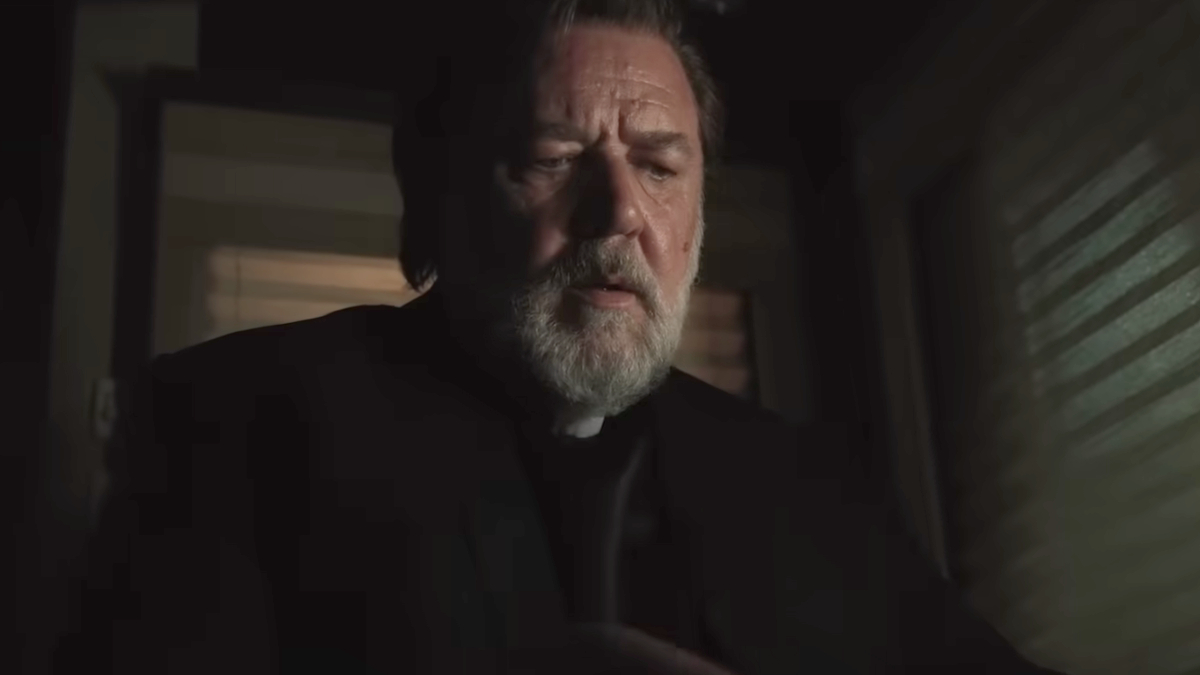Alexandre Bustillo and Julien Maury‘s Leatherface is yet another unique interpretation of Texas Chainsaw tonality. This is the beginnings of evil; a moody dive behind the monster’s mask. After The Texas Chainsaw Massacre 2 introduced a colorful misery, after roadkill grindhouse turned darkly comical, after 2003’s “gritty, dark reboot.” The filmmakers behind Inside, Livide and Among The Living use Seth M. Sherwood’s screenplay to explore what could drive one child to his slaughterhouse obsession – with mixed results. As a Southern-strong franchise entry, it’s certainly not the worst (cough – Texas Chainsaw 3D – cough). But as a Bustillo and Maury product? Well, let’s just say we’ve seen them be more aggressive, better inspired and vastly richer when developing human characteristics.
Sherwood’s tale opens on a celebratory gathering. Verna Sawyer (Lili Taylor) presents a young Jed Saywer (Boris Kabakchiev) with his first chainsaw. Happy birthday! Jed revs the handheld slicer but can’t bring himself to finish off his first victim – Grandpa has to complete the job with a hammer thwap to the head. It’s memorable for all the wrong reasons, but Jed’s nightmare isn’t over yet.
Fast-forward to 1955 (or maybe it already is, thanks awkward title card placement), where a pig-costumed Jed lures Betty Hartman (Lorina Kamburova) into some abandoned barn. Long story short, she’s incapacitated then crushed by a tractor engine at the hand of Verna’s clan – leaving Texas Ranger Hal Hartman (Stephen Dorff) with a dead daughter. Jed Sawyer is sent to be institutionalized and Hartman removes custody from Verna. First chapter over.
All that for an introduction?
Speed ahead another ten years where we meet compassionate Jackson (Sam Strike), brutish Bud (Sam Coleman) and sadistic Ike (James Bloor) – all patients of Gorman House Youth Reformatory – one of whom is Jed Sawyer. This becomes the game Leatherface plays, since inhabitants are renamed to distance victims from their traumas. Verna ends up freeing the entirety of Gorman’s subjects – those who don’t murder one another like savages. Ike’s Bonnie to his Clyde joins the boy’s escape – the deadly Clarice (Jessica Madsen) – along with their hostage, nurse Lizzy (Vanessa Grasee). Meanwhile, we’re left wondering who will live to become Leatherface.
In going the dead-serious origin route, we sympathetically view Jed Sawyer as a misguided youth. Pressured into a life of murderous servitude by Verna, “saved” by crooked lawman Hartman, then failed by humanity. As cynical adages go, our vile society is responsible for creating Leatherface. Characters lie, corrupt and prove to Jed that kindness is never replayed; his chainsaw carnage just a projection of the viciousness that life’s deck deals. Jed’s spark of innocence is extinguished in order to reveal horror’s greatest hardware supporter – Leatherface is just a malicious offspring of hate, revenge and disgust.
The issue? You’ve heard this birthright story before, and for such a household maniac, the impact never matches legacy.
Bustillo and Maury are no strangers to brutalized gore and Leatherface doesn’t skimp. Deaths are nasty, savage, and meant to upset. Heads crack like coconuts while gunshots blow chunks of skull all over quaint pitstop restaurants. It is…grotesque – but mean in spirit. Sherwood’s characters massacre for fun, like Natural Born Killers with slasher implications. Yet, because Bustillo and Maury choose such a darkened, ceremoniously deranged dear-air tone, the film makes you feel icky in the wrong genre ways. Connections and investment in character might have made such impassioned sinning more meaningful in the same way Rob Zombie might have been able to liven up these children’s war path. As is, though? It just feels like a name-branded prequel with ill-guided intentions.
Frustratingly, Leatherface never defines the film it wants to be. A Texas Chainsaw saws-all corpse carver? A Devil’s Rejects brand of anarchistic roadside family-comes-first squealer? Some fabled societal satire about one child turning into a mute serial killer because of wayward morality? Sherwood deems only The Texas Chainsaw Massacre (1974) and Texas Chainsaw 3D (2013) worthy of canonical ties, but fails to alter horror history with what should be a bombshell beginning for Texas’ Saint of Slashings. It’s all Sawyer nostalgia without clear delineation or necessary usage from blink-and-you’ll-miss cameos (Ted Hardesty/Nubbins Sawyer) to clashing acts that care more about shocks than storytelling (“Hey, necrophilia would be pretty rad right about now!”).
Lili Taylor as Sawyer matriarch Verna and Stephen Dorff as child-hating Hal Hartman (another Texas Chainsaw 3D link) serve up unhinged genre performances with savory meatiness, though the same can’t be said for the younger cast members. It’s understood that Jacob, Bud, Ike and Clarice all come from disturbed backgrounds, but pervasiveness becomes repetitive – Jackson trying to save sweetheart Lizzy, Lizzy continually almost getting Jackson killed when she attempts escape.
Then we have Ike, the waitress-killin,’ female violatin,’ shotgun-totin’ scoundrel whose relationship with Clarice is nothing but grindhouse fodder – except Leatherface never wants to be such a midnighter. Bud, meanwhile, is the reddest of red herrings, tortured for “dramatic” effect – without redemption discovered. Sherwood admits that most archetypes were inspired by existing Texas Chainsaw personalities (Clarice via Chop Top, for example), which makes sense since the film and its characters resemble nothing but inspired offshoots – not a blood franchise relative.
Leatherface is a fatty, butchered cut of Grade-A horror decadence that’s confusing to the palate. Expectations stem from a 70s slasher classic, yet Alexandre Bustillo and Julien Maury evoke their own on-screen signatures in obtuse ways. Death sequences will flay your skin, cinematography strikes similar chords to Among The Living, but characters become lost in mythos and references that mean little in the end.
You’ll begin your watch hungry for answers and origin hype, only to end on a rancid note of forgettable transformation. Leatherface is eventually unveiled – first flesh mask and all – though it’s to an audience now wondering what the preceding 80-or-so minutes even meant. Chainsaws rev and nightmares are born, albeit through grimy, sloppy means that never live up to the demented Sawyer legend.






